
- 'OK' for each choice
- 'No more choices' after you have clicked OK for the last one.
- 'Remove last' to remove the last choice you just defined. You can remove them all one after another to correct a mistake somewhere.
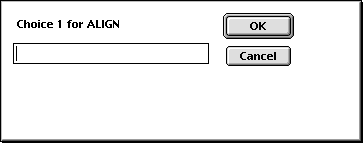
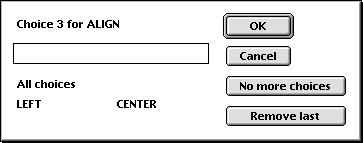
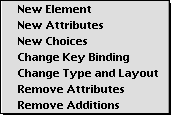
To add new HTML elements, or new attributes to existing elements, to HTML mode. HTML is continuously evolving and many browsers have introduced their own extensions. Here you can add what is missing. New elements will be put in a new submenu 'Custom' of the HTML menu.
You can only add new elements to the extensions package. HTML 3.2 is complete as it is.
IMPORTANT! If you have previously defined new HTML elements in the preferences file HTMLPrefs.tcl (could be done in HTML mode 1.1.1 and earlier), make sure you remove all of them and restart Alpha before using this function. Otherwise there is a risk of conflicts between the two ways of adding elements. If you have element definitions in your prefs file and you already have loaded HTML mode, you may have seen a warning message that the way to add new elements has changed. This warning message is shown if you call the function htmlNewElemVar of define the variable htmlCustomMenuList. Remove all such things from the prefs file and restart Alpha to avoid this warning.
New Element - To add a new HTML element.
The elements are divided into three categories.
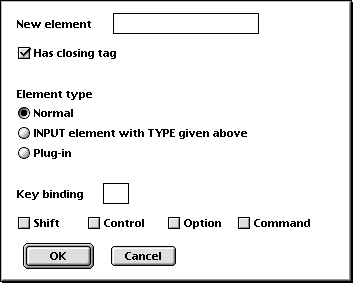
In the first dialog shown above you specify the following.
Next you are asked to specify all the attributes to the element. (I would say that it is a good idea to write down the complete definition on a piece of paper before you start.)
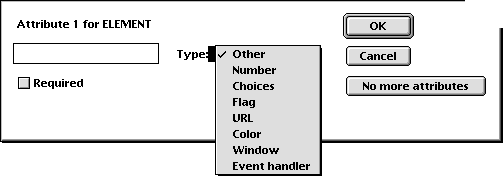
In the first dialog for each attribute (shown above) you specify:
The attributes you define will be displayed in the dialog window as you go along, as shown below.

Then click
The different types are



Once you have specified all attributes you will be presented with a final dialog box (one of the two below), where you are asked which layout you want in the html documents. (This layout only determines how the tags are inserted in the text document, and affects, of course, not how the text is displayed by the browser.)
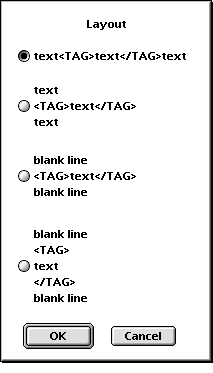
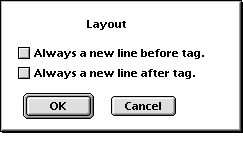
For elements without a closing tag you can specify if you always want a carriage return inserted before and/or after the tag.
For elements with a closing tag, you can choose between four different layouts, whether you want the tags to be on lines of their own and if you want blank lines before and after them.
The new element is now saved and after that, if you use the status bar to input attributes, you will be asked to select which optional attributes you want to be asked about.
New Attributes - To add new attributes to an existing HTML element. You are first presented with a list from which you choose an element to add attributes to. In this list 'LI IN UL' and 'LI IN OL' are the LI element for UL and OL lists respectively. BUTTON, CHECKBOX, FILE, HIDDEN, IMAGE, PASSWORD, RADIO, RESET, SUBMIT and TEXT are the INPUT element with different TYPEs. LIVEAUDIO, LIVEVIDEO, QUICKTIME MOVIE, QUICKTIME VR and REALAUDIO are different plug-ins. All the rest are the usual names of the elements. Then you specify the attributes in the same way as you specify the attributes to a new element as described above.
New Choices - To add new choices to an attribute with predefined choices. You are first presented with a list from which you choose the element with the attribute to add to. Second, you are presented with a list from which you select the attribute. Then you specify new choices in the same way as described above.
Change Key Binding - To change a key binding for a custom element. Note that you can only change the key bindings for the elements you have added yourself. You are presented with a dialog box, as shown below, where you specify the key and which of the modifiers shift, control, option and command you want. To remove the key binding, leave the text box blank.
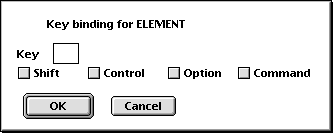
Change Type and Layout - To change the layout of a custom element, to change whether it has a closing tag or not, and to change its type (normal, input element or plugin).

Remove Attributes - To remove one or more of the attributes you have added to some element, or to remove choices you have added to an attribute. You are first presented with a list of all elements you have added attributes to. Select the element you want and you are then presented with a list with all attributes you have added to this element, where you can select the ones you want to remove. If you have only added new choices to an attribute, only these choices are removed, not the attribute itself.
There is no function to directly change an attribute. (This is something I hopefully will get around to add someday.) To change an attribute you have to first remove it and then add a new one again.
Remove Additions - To remove an element you have added or to remove additions you have made to a predefined element. With this function you remove all additions you have made to an element.